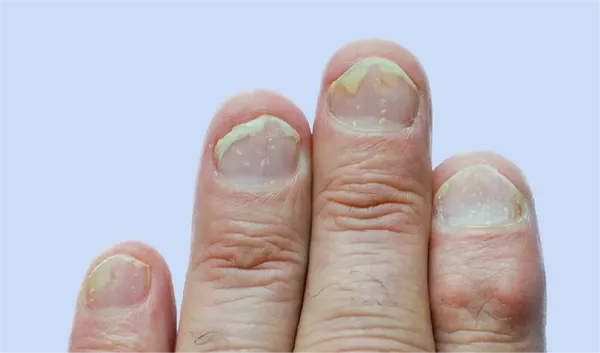Toenail psoriasis is a condition that affects the nails, causing various changes that can impact a person’s quality of life. While it shares some similarities with other nail disorders, toenail psoriasis has distinct characteristics that set it apart. In this article, we will explore what toenail psoriasis is, what causes it, its symptoms, how it is diagnosed, and the best ways to manage it.
1. Definition and Explanation
What is toenail psoriasis?
Toenail psoriasis is a chronic autoimmune condition where the body’s immune system mistakenly attacks healthy nail cells, leading to abnormal nail growth and changes in appearance. It is a subtype of psoriasis, a broader skin condition known for causing red, scaly patches on the skin. Toenail psoriasis specifically targets the toenails, resulting in symptoms that can be both visually unappealing and uncomfortable.
SEE ALSO: Are Hot Showers Bad for Psoriasis?
How common is toenail psoriasis?
Toenail psoriasis is relatively common among people with psoriasis. It is estimated that up to 50% of individuals with psoriasis will experience nail involvement at some point, with toenails being affected in about 35% of these cases. The prevalence of toenail psoriasis increases with age and is more common in individuals with a family history of the condition.
2. Causes and Risk Factors
What causes toenail psoriasis?
The exact cause of toenail psoriasis is not fully understood, but it is known to be an autoimmune disorder. The immune system, which normally protects the body from infections and diseases, mistakenly attacks healthy nail cells, causing inflammation and abnormal nail growth. This immune response is often triggered by a combination of genetic and environmental factors.
What are the risk factors for toenail psoriasis?
Family History: A strong genetic link exists in psoriasis, including toenail psoriasis. If you have a close relative with the condition, your risk is higher.
Other Skin Conditions: Individuals with psoriasis, particularly those with plaque psoriasis, are more likely to develop toenail psoriasis.
Immune System Dysfunction: Conditions that affect the immune system, such as HIV or autoimmune disorders, can increase the risk of toenail psoriasis.
Medications: Certain medications, including beta-blockers, lithium, and antimalarial drugs, can trigger or worsen psoriasis, including the nail variant.
Injuries to the Nails: Trauma or repeated injury to the toenails can precipitate or exacerbate toenail psoriasis.
3. Symptoms and Diagnosis
Thickening of the Nail: The affected toenail may become thicker than normal, making it difficult to trim and causing discomfort.
Discoloration: The nail may change color, often turning yellow, brown, or white.
Pitting: Small depressions or pits may appear on the surface of the nail.
Separation from the Nail Bed (Onycholysis): The nail may lift away from the nail bed, creating a space where dirt and debris can accumulate.
Crumbly or Brittle Nails: The nail may become crumbly or brittle, breaking easily.
Red or White Spots: Discoloration under the nail can appear as red or white spots.
How is toenail psoriasis diagnosed?
Diagnosis of toenail psoriasis typically begins with a physical examination by a dermatologist or healthcare provider. The doctor will look for the characteristic signs of psoriasis on the nails and may ask about your medical history and any family history of psoriasis. To rule out other conditions, such as a fungal nail infection, the doctor may take a nail clipping for a biopsy or perform a fungal culture. These tests help differentiate toenail psoriasis from other similar conditions.
4. Treatment and Management
Topical Medications: Creams, ointments, and gels containing corticosteroids or vitamin D analogs are often applied directly to the affected nails to reduce inflammation and slow abnormal nail growth.
Oral Medications: In more severe cases, oral medications such as methotrexate, cyclosporine, or biologics that target specific parts of the immune system may be prescribed.
Phototherapy: Light therapy, also known as phototherapy, can be used to treat nail psoriasis by exposing the affected nails to ultraviolet light under medical supervision.
Nail Removal: In extreme cases where the nail is severely affected, surgical removal of the nail may be recommended. This allows for a new, healthier nail to grow in its place.
How can I manage toenail psoriasis?
Maintain Good Nail Hygiene: Keep your nails clean and trimmed to prevent infections and reduce the risk of further nail damage.
Avoid Injury to the Nails: Protect your toenails from trauma by wearing comfortable shoes and avoiding activities that may cause nail injuries.
Moisturize Regularly: Applying moisturizers to the nails and surrounding skin can help prevent dryness and reduce the risk of nail cracking.
Seek Professional Advice: Regular check-ups with a dermatologist can help monitor the condition and adjust treatment as needed.
Conclusion
Toenail psoriasis can be a challenging condition to manage, but with the right treatment and care, you can maintain the health and appearance of your nails. By staying informed and working closely with your healthcare provider, you can effectively manage this condition and improve your quality of life.
Related Topics:



























